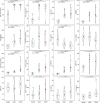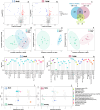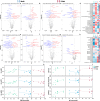Lipidomic signatures linked to gut microbiota alterations in children and adolescents with type 2 diabetes mellitus and metabolic syndrome
- PMID: 40461716
- PMCID: PMC12134222
- DOI: 10.1038/s41598-025-04343-3
Lipidomic signatures linked to gut microbiota alterations in children and adolescents with type 2 diabetes mellitus and metabolic syndrome
Abstract
Youth-onset type 2 diabetes mellitus (T2DM) has an aggressive clinical course and is usually preceded by obesity and metabolic syndrome (MetS). Lipids have emerged as potential biomarkers for studying metabolic risk factors and predicting disease progression. An untargeted lipidomic analysis by liquid chromatography-mass spectrometry was performed in thirty pediatric subjects with T2DM and MetS and a healthy group. Plasma lipids were associated with obesity, metabolic risk factors, inflammatory biomarkers, and gut microbiota. A total of 375 lipid species were annotated. MetS and T2DM groups had increased levels of phosphocholines (15-18), phosphoinositols (2-3), sphingomyelins (2-3), and triglycerides (1-4), and lower plasmalogens (2-6) and lysophospholipids (1-2). Phosphocholines, phosphoinositols, sphingomyelins, and triglycerides positively correlated with metabolic risk factors such as body mass index (BMI), waist and hip circumference, triglycerides, glucose, insulin, and HOMA-IR. Ceramides were significantly higher in MetS and T2DM in regression analysis, adjusted for BMI, age, and sex, and only increased with higher BMI in the healthy group. Significant positive correlations were observed for phosphocholines and phosphoinositols with species from the phyla Pseudomonadota and Bacillota, like Weissella cibaria and Enterobacter hormaechei, and the latter species with ceramides. This study provides novel evidence on the role of plasma lipids in the pathophysiology of MetS and T2DM in children and adolescents and their associations with gut microbial species. These findings documented opportunities for developing therapeutic strategies, such as dietary interventions and microbiome modulation, to mitigate the burden of metabolic diseases in pediatric populations.
Keywords: Children; Gut microbiota; Lipidomics; Metabolic syndrome; Type 2 diabetes mellitus.
© 2025. The Author(s).
Conflict of interest statement
Declarations. Competing interests: The authors declare no competing interests.
Figures







Similar articles
-
Characterization of gut microbiota associated with metabolic syndrome and type-2 diabetes mellitus in Mexican pediatric subjects.BMC Pediatr. 2023 May 3;23(1):210. doi: 10.1186/s12887-023-03983-6. BMC Pediatr. 2023. PMID: 37138212 Free PMC article.
-
Comparison of clinical and biochemical variables in type 2 diabetes mellitus patients and their first-degree relatives with metabolic syndrome in Benin City, Nigeria: A cross sectional case controlled study.Endocr Regul. 2016 Jan;50(1):32-40. doi: 10.1515/enr-2016-0007. Endocr Regul. 2016. PMID: 27560635
-
Metabolic syndrome in nondiabetic, obese, first-degree relatives of African American patients with type 2 diabetes: African American triglycerides-HDL-C and insulin resistance paradox.Ethn Dis. 2006 Autumn;16(4):830-6. Ethn Dis. 2006. PMID: 17061734
-
Gut microbiota associations with metabolic syndrome and relevance of its study in pediatric subjects.Gut Microbes. 2021 Jan-Dec;13(1):1960135. doi: 10.1080/19490976.2021.1960135. Gut Microbes. 2021. PMID: 34491882 Free PMC article. Review.
-
The roles of dietary lipids and lipidomics in gut-brain axis in type 2 diabetes mellitus.J Transl Med. 2023 Apr 2;21(1):240. doi: 10.1186/s12967-023-04088-5. J Transl Med. 2023. PMID: 37009872 Free PMC article. Review.
References
-
- World Health Organization. Obesity and overweight. https://www.who.int/news-room/fact-sheets/detail/obesity-and-overweight (2024).
-
- Barata Cavalcanti, O. et al. World Obesity Atlas 2022. (2022).
MeSH terms
Substances
Grants and funding
LinkOut - more resources
Full Text Sources
Medical

